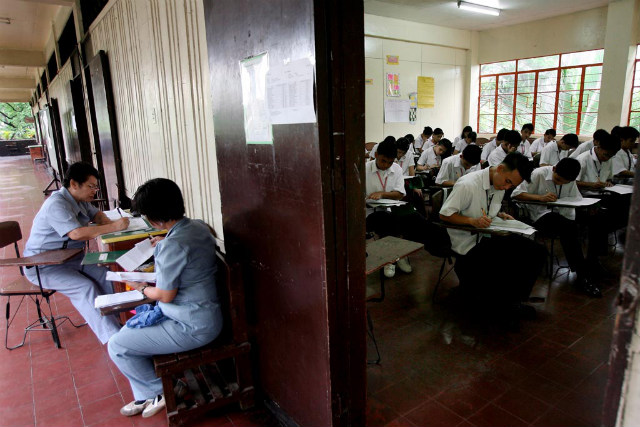SUMMARY
This is AI generated summarization, which may have errors. For context, always refer to the full article.

MANILA, Philippines – The Catholic Bishops’ Conference of the Philippines (CBCP) is urging Catholic schools not to retrench teachers displaced by a new curriculum that transfers basic college subjects to high school.
In a statement on Thursday, June 26, CBCP president Lingayen-Dagupan Archbishop Socrates Villegas said that while the Philippines’ labor law “makes available the options of the redundancy and retrenchment provisions, provided legal conditions are complied with,” Catholic schools should also consider the law of “charity.”
“Charity is a law for Catholic schools that takes precedence over all human law, for its origin is the very reason that our Catholic schools exist – the Lord Jesus. Turning away many of the faithful co-workers we have had who have been loyal to our schools and to the local Church for all these years is a most unwelcome prospect, and we dissuade our Catholic school administrators from finding recourse in these provisions of law all too easily,” Villegas said.
The CBCP released this statement as college professors fear massive retrenchment starting 2016, when students enter high school’s grade 11 – not first year college – for the first time.
Colleges expect lower enrollment in 2016, then in 2017, when students enter grade 12, until school years 2021 to 2022 when the situation will likely normalize.
‘Be creative’
Rene Tadle, internal vice president of the University of Santo Tomas’ faculty union, said the K to 12 program will affect around 30,000 professors and 15,000 non-teaching staff either by retrenchment to prevent losses, redundancy, or early retirement.
In the CBCP statement, Villegas said, “The debate on whether we should adopt the K to 12 scheme is behind us. We have accepted it, but we must now cope with the challenges that it has engendered.”
“Obviously, the most pressing problem has to do with our Catholic educators – both academic and non-academic partners – who will have no students to attend to in the first year of higher education, for the first year of the implementation of K to 12, and then for the first two years, in the second year of the scheme’s implementation,” he added.
“We urge the trustees of our Catholic school corporations and school officials to be creative,” the Philippines’ top prelate said.
He said the CBCP “strongly” exhorts school administrators “to provide opportunities for the re-tooling and re-training of our instructors and professors in tertiary education to be able to handle subjects in the academic track of senior high school.”
“Our Catholic school teachers and instructors should not be left to their own devices. Our priests who serve on positions of school directorship, must, in all charity and solicitude, aid them so that they may continue as our partners in the apostolate of Catholic education,” he said.
Displacement a ‘last recourse’
He also urged Catholic colleges “to apply, where deemed feasible and appropriate, to operate senior high school.”
“Since most of our diocesan colleges also offer secondary school education, this should not be a problem. And in the design of the curriculum for the additional years of high school, we direct that Catholic schools keep ever in mind the raison d’etre of our Catholic schools: evangelization and formation,” Villegas said.
He added: “In this respect, whatever the purposes of the government might be – many of which are laudable – our Catholic schools cannot excuse themselves from the responsibility of tailoring curricula to fulfill their mandate of evangelization and formation by slavish adherence to model curricula.”
The government, however, sees displacement as a last recourse since schools can move college teachers to senior high school, said Benjo Benavidez, officer-in-charge of the Bureau of Labor Relations at the Department of Labor and Employment.
Benavidez said the government will release guidelines for these teachers’ employers by the end of June.
Signed into law in 2013, the K to 12 adds two years to basic education to produce world-class Philippine graduates. (INFOGRAPHIC: 10 things about K to 12) – Rappler.com
Add a comment
How does this make you feel?
There are no comments yet. Add your comment to start the conversation.